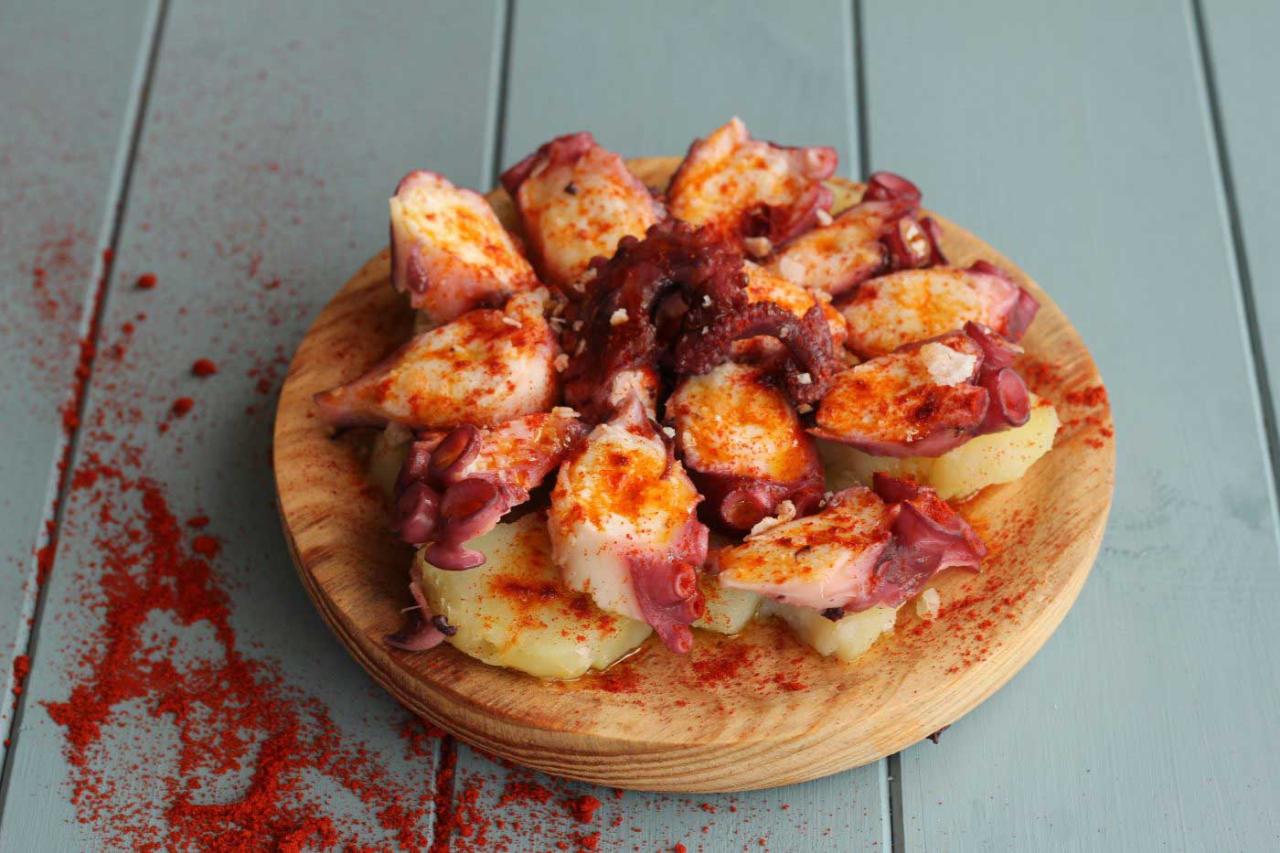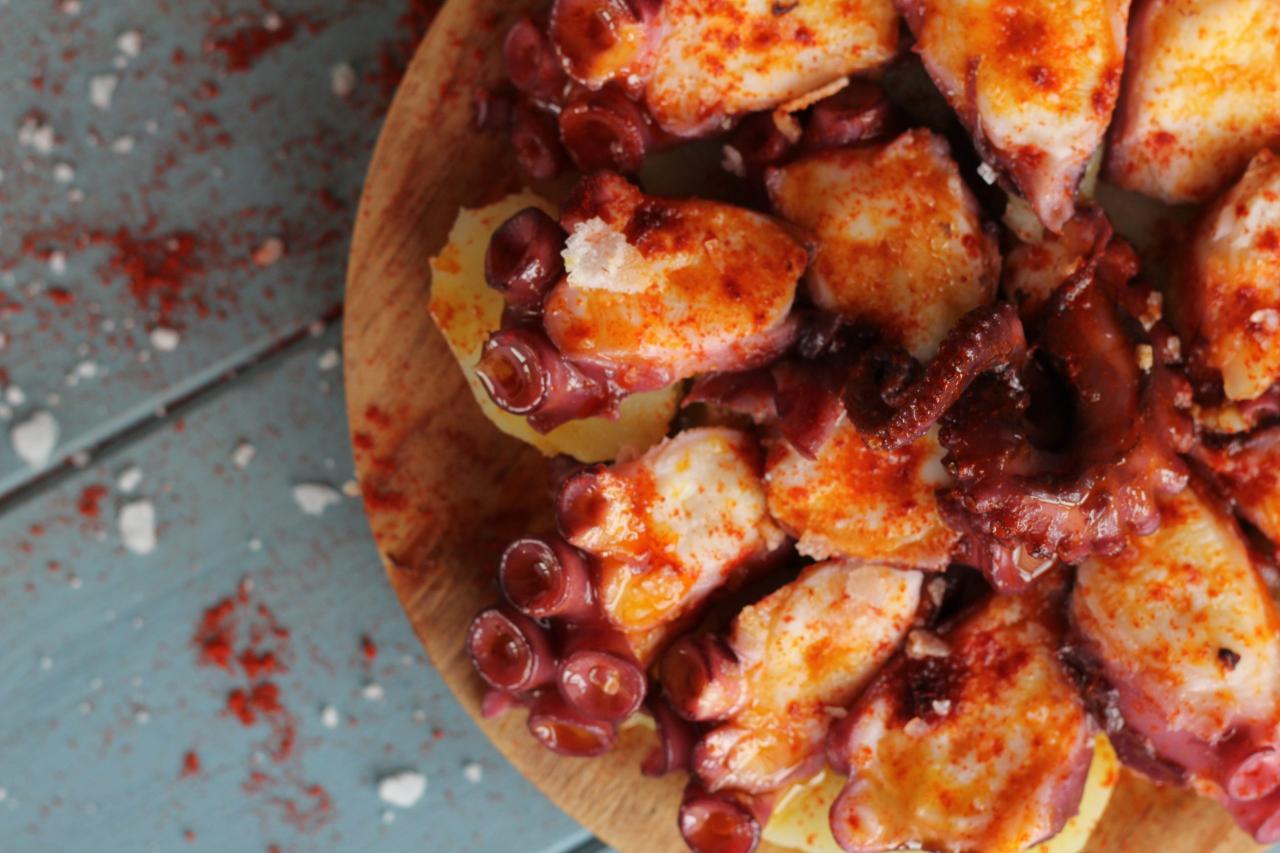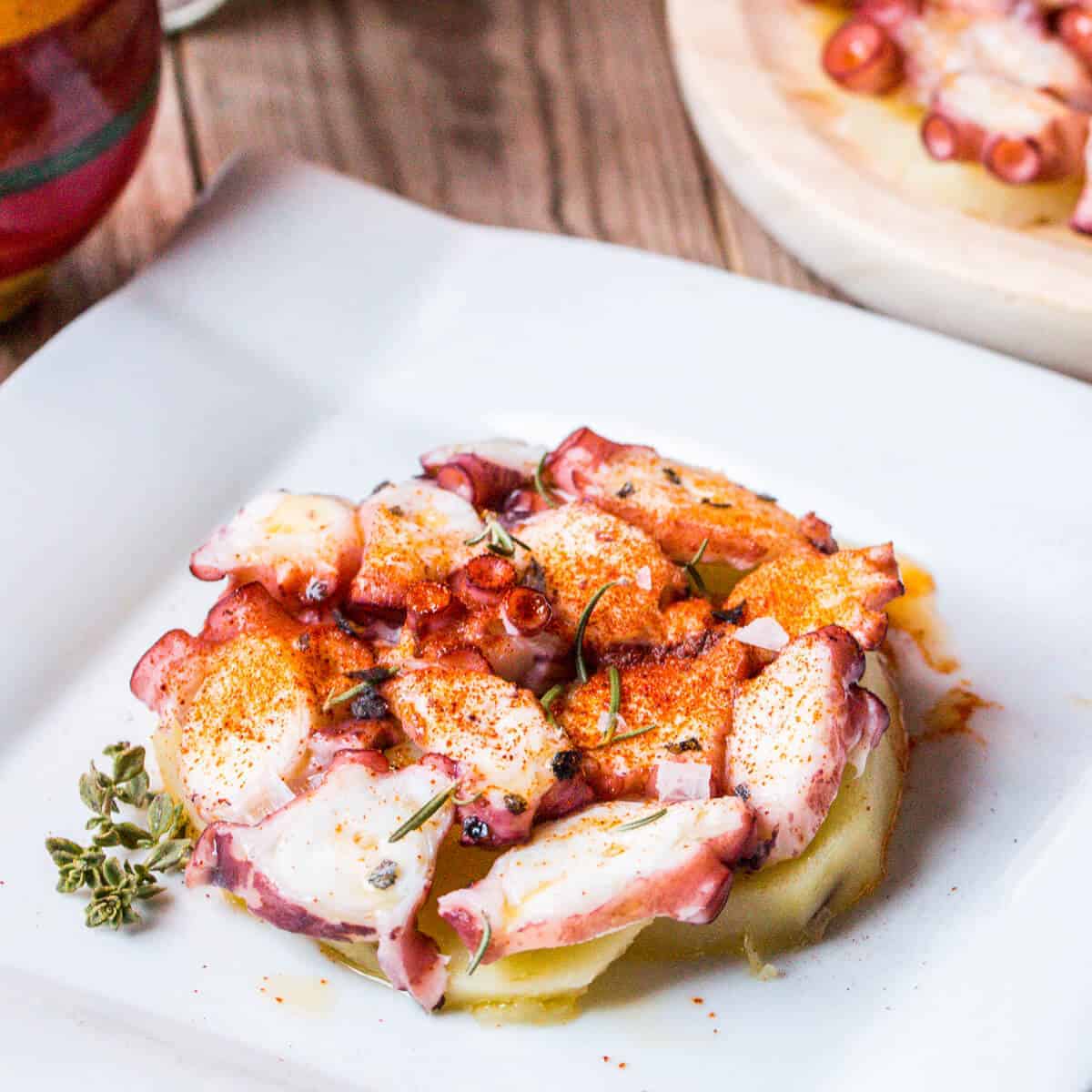During a journey steeped in the discovery of Galicia’s stunning landscapes and its culinary treasures, I was delighted to encounter “Pulpo a la Gallega,” an iconic dish that encapsulates the soul of Spanish gastronomy. This traditional Galician delicacy, with its tender octopus, piquant Spanish paprika, and hearty potatoes, invites a deep dive into a world of flavors that are both grounded and profoundly aromatic. The octopus emerges impeccably soft, almost melting upon contact, contrasted by the smoky warmth of the paprika and the comforting simplicity of boiled potatoes. Fascinated by this harmonious blend of textures and tastes, I embarked on a quest to replicate this culinary masterpiece at home. After several attempts, nuanced adjustments, and a dedication to sourcing the finest ingredients, I achieved a version of “Pulpo a la Gallega” that transported me back to those Galician shores. It is with immense pleasure and a hint of pride that I now share this recipe, inviting you to savor a piece of Galicia’s rich culinary heritage from the comfort of your kitchen.

Pulpo a la Gallega
Equipment
- 1 big saucepan
Ingredients
- Spanish paprika
- Extra virgin olive oil
- 500 g of potatoes
- Sea salt flakes
- 1 whole fresh octopus
Instructions
- With a grain of salt, bring a big saucepan of water to a boil.
- On a moderate flame, cook your octopus for 15 to 20 minutes.
- You may check whether the octopus is done towards the middle of the cooking procedure by poking the thicker tentacle with a bamboo club to see if they are soft enough.
- Add the garlic and simmer till tender while the octopus is cooking.
- Allow it to cool for a few minutes.
- Slice the octopus tentacles and potato into 1⁄2 inch thinly sliced to serve.
- With sea salt, cayenne pepper, and a nice drizzle of olive oil, complete the dish.
Cooking tips baout Pulpo a la Gallega

- Selecting the Octopus: The key to a perfect Pulpo a la Gallega lies in the quality of the octopus. Fresh octopus is ideal, but frozen can also produce excellent results, as freezing helps tenderize the meat.
- Tenderizing the Octopus: Boil the octopus with a cork or in vigorously boiling water, dipping it three times before fully immersing it to curl the tentacles beautifully and start the tenderizing process. Cook it until it’s fork-tender, which can vary depending on the size of the octopus.
- Potato Base: Boil potatoes until they are just tender and slice them as the foundation of the dish. The potatoes not only serve as a bed for the octopus but also absorb its flavors and the seasoning, enhancing the overall dish.
- Slicing Techniques: Once cooked and slightly cooled, cut the octopus into bite-sized pieces using kitchen shears or a sharp knife. This ensures that each piece is easy to eat and allows for equal distribution of seasoning.
- The Right Paprika: Spanish smoked paprika (pimentón) is essential for achieving the authentic flavor. Sprinkle generously over the sliced octopus and potatoes. You’ll find that the smoky paprika not only adds spice but also a deep, rich color and aroma that is characteristic of Pulpo a la Gallega.
- Seasoning Balance: Along with paprika, coarse sea salt, and a drizzle of high-quality extra virgin olive oil complete the dish. These elements should be balanced to enhance, not overpower, the natural flavors of the octopus and potatoes.
- Serving Tradition: Serve Pulpo a la Gallega on a wooden platter, as is traditional, to retain warmth. This not only adds to the presentation but also keeps the dish warm as it’s enjoyed.
- Accompaniments: While Pulpo a la Gallega can stand alone as a vibrant dish, it pairs wonderfully with a crisp, dry white wine, such as Albariño from the same Galician region, complementing the dish’s flavors and adding to the overall dining experience.
Serving suggestions about Pulpo a la Gallega

- Wooden Platter Presentation: True to the traditional Galician way, serve Pulpo a la Gallega on a wooden platter. The rustic charm of the wood complements the simple elegance of the dish, and it helps retain the warmth of the octopus and potatoes.
- With a Slice of Country Bread: Offer thick slices of rustic, crusty country bread alongside Pulpo a la Gallega. The bread is perfect for dipping into the olive oil and paprika-infused juices that dress the octopus and potatoes.
- Pair with Galician Wines: Enhance the dining experience with a bottle of crisp, dry white wine from Galicia, such as Albariño or Godello. These wines, with their bright acidity and subtle minerality, harmonize beautifully with the flavors of the pulpo, creating a perfect pairing.
- Pimentón Sprinkle: Just before serving, give the dish an extra sprinkle of Spanish smoked paprika (pimentón) for a burst of color and a smoky aroma that tantalizes the senses, inviting diners to delve into the dish.
- Side of Padrón Peppers: Complement Pulpo a la Gallega with a side of sautéed Padrón peppers. These small green peppers, lightly fried in olive oil and sprinkled with coarse salt, offer a delightful contrast in flavor and texture.
- Lemon Wedges: Although not traditional, providing lemon wedges on the side allows guests to add a fresh squeeze of lemon juice if desired. The acidity can enhance the flavors of the octopus and potatoes for those who enjoy a little zest.
- Galician-Style Greens: Accompany the dish with a side of grelos (turnip tops) or another leafy green vegetable, sautéed with garlic. This adds a touch of freshness and completes the meal with a nod to Galician vegetable traditions.
Top 5 FAQs about Pulpo a la Gallega

- What is Pulpo a la Gallega? Pulpo a la Gallega, also known as Octopus Galician Style, is a traditional dish from the Galician region of Spain, centered around boiled octopus. It’s characterized by its tender texture and is seasoned with Spanish paprika, coarse sea salt, and olive oil, usually served on a bed of boiled potatoes. This dish showcases the simplicity yet profound flavors of Spanish cuisine.
- What are the key ingredients in Pulpo a la Gallega? The key ingredients that define Pulpo a la Gallega include octopus, Spanish smoked paprika (pimentón), coarse sea salt, olive oil, and potatoes. These elements come together to create a dish that balances the delicate taste of the octopus with the smoky warmth of paprika and the comforting texture of potatoes.
- How do you achieve the perfect texture for the octopus? Achieving the perfect texture for the octopus involves tenderizing it correctly. This is traditionally done by boiling the octopus with a cork (an old chef’s trick) or by dipping it three times in vigorously boiling water before fully immersing it. The process helps to curl the tentacles and start the tenderization process, and it should be cooked until fork-tender. The exact cooking time may vary based on the size of the octopus.
- What makes Spanish smoked paprika (pimentón) essential for this dish? Spanish smoked paprika, or pimentón, is essential for achieving the authentic flavor of Pulpo a la Gallega. It provides a distinctive smoky warmth and deep red color that significantly enhances the overall taste and aroma of the dish, setting it apart from other octopus preparations.
- Any tips for serving Pulpo a la Gallega authentically? For an authentic serving experience, present Pulpo a la Gallega on a wooden platter to retain warmth and add to the presentation. It is traditionally accompanied by a slice of country bread, perfect for dipping into the seasoned olive oil, and may be paired with a crisp, dry white wine, like Albariño, from the Galician region. This not only respects tradition but also complements the flavors of the pulpo beautifully, creating a more immersive dining experience.

Leave a Reply